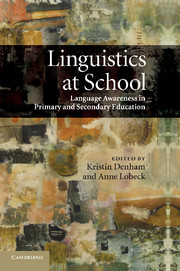Book contents
- Frontmatter
- Contents
- Notes on contributors
- Foreword: The challenge for education
- Introduction
- Part I Linguistics from the top down: encouraging institutional change
- Part II Linguistics from the bottom up: encouraging classroom change
- Introduction to Part II
- 9 From cold shoulder to funded welcome: lessons from the trenches of dialectally diverse classrooms
- 10 Positioning linguists as learners in K-12 schools
- 11 Fostering teacher change: effective professional development for sociolinguistic diversity
- 12 On promoting linguistics literacy: bringing language science to the English classroom
- 13 Linguistics in a primary school
- 14 Educating linguists: how partner teaching enriches linguistics
- 15 The Linguistic Olympiads: academic competitions in linguistics for secondary school students
- Part III Vignettes: voices from the classroom
- References
- Index
Introduction to Part II
Published online by Cambridge University Press: 04 August 2010
- Frontmatter
- Contents
- Notes on contributors
- Foreword: The challenge for education
- Introduction
- Part I Linguistics from the top down: encouraging institutional change
- Part II Linguistics from the bottom up: encouraging classroom change
- Introduction to Part II
- 9 From cold shoulder to funded welcome: lessons from the trenches of dialectally diverse classrooms
- 10 Positioning linguists as learners in K-12 schools
- 11 Fostering teacher change: effective professional development for sociolinguistic diversity
- 12 On promoting linguistics literacy: bringing language science to the English classroom
- 13 Linguistics in a primary school
- 14 Educating linguists: how partner teaching enriches linguistics
- 15 The Linguistic Olympiads: academic competitions in linguistics for secondary school students
- Part III Vignettes: voices from the classroom
- References
- Index
Summary
The contributions in Part II concern successful “bottom-up” projects involving linguists working in primary and secondary schools in partnership with K-12 teachers. As in Part I, the projects discussed here are diverse, but several themes emerge. One is the necessity for linguists doing such work to transition from “expert” to “learner,” in order to truly understand not only which language issues are of concern to teachers, but also why teachers teach what they do and how they do so. Of primary concern to K-12 teachers are lessons that help meet existing educational goals in effective ways. Linguists must therefore often leave their own agendas at the door, and realize that the linguistic knowledge we hope to integrate into the curriculum can emerge in other, sometimes unexpected ways, building a strong bridge between theory and practice. A companion theme in this section is that linguist–teacher partnerships not only change K-12 education in positive ways, but also have a positive impact on linguistics. Linguists learning how teachers teach, how students learn, and how linguistics fits into K-12 education are “doing linguistics” in ways that have not always been respected within the academy. The authors demonstrate the importance and effectiveness of bringing linguistics out of the academy and into the public eye and mind.
Rebecca Wheeler's chapter traces her personal journey from rejection to acceptance in the schools, and some of the difficult lessons she learned in her attempts to help teachers teach their students, speakers of African American Vernacular English, to write in Standard English.
- Type
- Chapter
- Information
- Linguistics at SchoolLanguage Awareness in Primary and Secondary Education, pp. 125 - 128Publisher: Cambridge University PressPrint publication year: 2010



